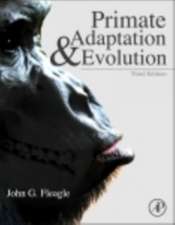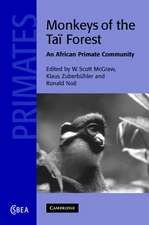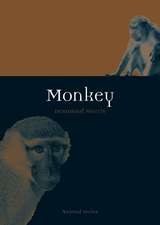The Evolution of Thought: Evolutionary Origins of Great Ape Intelligence
Editat de Anne E. Russon, David R. Begunen Limba Engleză Paperback – 22 iul 2007
Preț: 361.16 lei
Nou
Puncte Express: 542
Preț estimativ în valută:
69.13€ • 75.12$ • 58.11£
69.13€ • 75.12$ • 58.11£
Carte tipărită la comandă
Livrare economică 21 aprilie-05 mai
Preluare comenzi: 021 569.72.76
Specificații
ISBN-13: 9780521039925
ISBN-10: 0521039924
Pagini: 396
Ilustrații: 36 b/w illus. 48 tables
Dimensiuni: 187 x 226 x 18 mm
Greutate: 0.7 kg
Editura: Cambridge University Press
Colecția Cambridge University Press
Locul publicării:Cambridge, United Kingdom
ISBN-10: 0521039924
Pagini: 396
Ilustrații: 36 b/w illus. 48 tables
Dimensiuni: 187 x 226 x 18 mm
Greutate: 0.7 kg
Editura: Cambridge University Press
Colecția Cambridge University Press
Locul publicării:Cambridge, United Kingdom
Cuprins
List of contributors; Preface; 1. Evolutionary reconstructions of great ape intelligence Anne E. Russon; 2. Enhanced cognitive capacity as a contingent fact of hominid phylogeny David R. Begun; Part I. Cognition in Living Great Apes: Introduction Anne E. Russon: 3. The manual skills and cognition that lie behind hominid tool use Richard W. Byrne; 4. The cognitive complexity of social organisation and socialisation in wild baboons and chimpanzees: guided participation, socialising interactions and event representation Sue Taylor Parker; 5. Gestural communication in the great apes Joanna Blake; 6. Great ape cognitive systems Anne E. Russon; Part II. Modern Great Ape Adaptation: Introduction Anne E. Russon: 7. What's in a brain? The question of a distinctive brain anatomy in great apes Carol E. MacLeod; 8. Life histories and the evolution of large brain size in great apes Caroline Ross; 9. Evolution of complex feeding techniques in primates: is this the origin of great ape intelligence? Gen Yamakoshi; 10. The special demands of great ape locomotion and posture Kevin D. Hunt; 11. Great ape social systems Carel P. van Schaik, Signe Preuschoft and David P. Watts; 12. Diet and foraging of the great apes: ecological constraints on their social organisations and implications for their divergence Juichi Yamagiwa; Part III. Fossil Great Ape Adaptations: Introduction David R. Begun: 13. Paleoenvironments and the evolution of adaptability in great apes Richard Potts; 14. Cranial evidence and the evolution of intelligence in fossil apes David R. Begun and László Kordos; 15. Life history and cognitive evolution in the apes Jay Kelley; 16. Fossil hominoid diets, extractive foraging and the origins of great ape intelligence Michelle Singleton; 17. Paleontology, terrestriality and the intelligence of great apes Daniel L. Gebo; 18. Body size and intelligence in hominoid evolution Carol V. Ward, Mark Flinn and David R. Begun; Part IV. Integration: 19. Evolutionary origins of great ape intelligence: an integrated view Anne E. Russon and David R. Begun; Author index; Species index; Subject index.
Recenzii
'… a good overview of the present state of research.' Gorilla Journal
'The book's strengths are several. The editors had a clear idea of what they wanted from their interdisciplinary encounter and they framed the process with welcoming introductory chapters and a masterly concluding one. Ethologists will find accessible even the most esoteric data … most chapters make a real effort to be understood by non-specialists … this is a brave and provocative book. It is a call to arms for true-disciplinary collaboration. Few ethologists know palaeontology, but all will learn from this bridge-building effort.' Ethology
'it may be impossible to travel back in time in order to reconstruct exactly the sequence of events that shaped the cognitive architecture of our nearest living and extinct relatives, but books like this one do a good job of allowing us to imagine the most likely scenarios, and of exposing gaps in knowledge that have to be filled for the complete picture to emerge.' Primates
'The book's strengths are several. The editors had a clear idea of what they wanted from their interdisciplinary encounter and they framed the process with welcoming introductory chapters and a masterly concluding one. Ethologists will find accessible even the most esoteric data … most chapters make a real effort to be understood by non-specialists … this is a brave and provocative book. It is a call to arms for true-disciplinary collaboration. Few ethologists know palaeontology, but all will learn from this bridge-building effort.' Ethology
'it may be impossible to travel back in time in order to reconstruct exactly the sequence of events that shaped the cognitive architecture of our nearest living and extinct relatives, but books like this one do a good job of allowing us to imagine the most likely scenarios, and of exposing gaps in knowledge that have to be filled for the complete picture to emerge.' Primates
Descriere
Reviews the reasons for and the nature of great ape intelligence and its implications for human intelligence.











